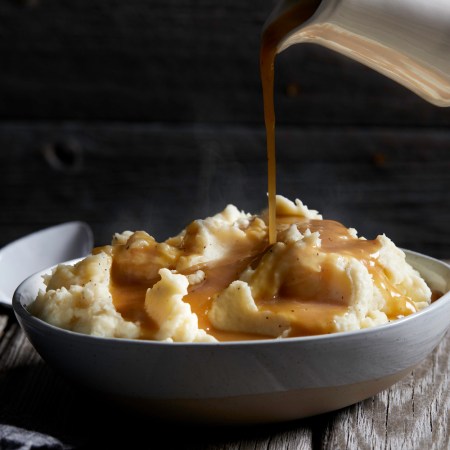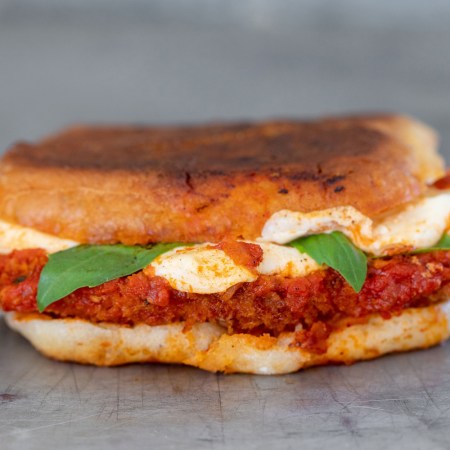You think you’re passionate about burgers.
But have you spent the last 10 years testing and experimenting to perfect your recipe? Because Chris Kronner — former chef of SF’s Bar Tartine and author of new grilling bible A Burger to Believe In — has.
Bay Area residents will recognize his surname from the now-defunct KronnerBurger, whose untimely demise was announced this year after just three years in operation. But locals can still get the goods at the newish Henry’s, and via regular pop-ups and residencies around the Bay.
For the rest of us, there’s his new book, published last month by Ten Speed Press, It’s a 240-page master study in the philosophy and craft of the American burger, in which he teaches home chefs the secrets of dry-aging their own beef, the golden ratio of toppings to meat to bun, how to perfectly char red onions and more.
Beyond beef, the book also has 40 recipes for rest of your meal, including the perfect chicken sandwich, salads and the the only condiment fit to grace a Kronnerburger: Cabot White Cheddar mayo. Whether you’re similarly obsessive or just want to up your game in time for grilling season, there’s something in there for everyone (even vegetarians).
In the meantime, we grilled him with 20 age-old burger conundrums, from correct order of assembly, to how many times (and when) to flip, to how to attempt a stuffed burger at home “without brutalizing the meat.”
And if you’re feeling lazy, he even confided the most consistently good fast-food burger he’s ever had. It wasn’t the Bay Area go-to we expected.
What is the ideal “doneness”? And if you don’t have a meat thermometer, how can you tell?
It depends on the burger. When dry-aged meat is used, we prepare them rare. The course grind and dry-aged meat eat best this way. Timing is a pretty consistent way to guarantee intended doneness: roughly two minutes on the first side, and one on the other. This requires a hot bed of coals or pan.
For burgers that have moister meat, medium rare or medium is fine. We time these as well. With a non-dry-aged patty, doneness can be felt: the spring of the meat is a good indicator. For well-done patties, I press them as thin as possible; they cook more quickly, lose less moisture and you don’t end up with a thick, dried-out patty.
How long should I let the meat rest before eating?
Generally we don’t. Because the meat is ground, it does not benefit from resting in the same way a solid piece of protein does. If the burger is rare, resting doesn’t really have any benefit.
Should you smash, pat or mold the patties before grilling?
I always weigh and mold the patties using a metal ring. It helps to compact the meat correctly without overworking it. It also makes cooking easier and more consistent.
How many times should I flip a burger?
Once. We give a quarter turn after the first minute then flip after the second. For a rare burger, we do not turn the burger a second time. A quarter turn on the second side is all you need. No second flip.
What’s the biggest error that novice burger makers make?
Adding unnecessary things to the grind or the burger itself. Start with the basics.
If you don’t have access to a grill, what are some tips for cooking on an indoor range?
A black steel pan, flat griddle or cast iron work best. They retain heat and allow for even cooking.
When is the best time to add cheese?
After the flip. I melt cheese under a broiler in order to not overcook the burgers.
What’s the most overlooked condiment or topping?
I prefer mayonnaise. No ketchup. No mustard. Our white-cheddar mayo acts as both cheese and sauce. Tangy and unctuous.
Mayo, mustard, ketchup. Rank ’em.
Depends on the burger. KronnerBurger is mayo only. I like thin patties with mustard and griddled or steamed onions. Ketchup is fine on thin patties as well.
What are the best burger greens?
Iceberg lettuce.
Is there such thing as too many toppings?
We keep it pretty simple. More than four toppings is usually a mess. The flavor should come from the beef and bun, not from candied horseshoe crab jam.
What’s the perfect bun, and must it be toasted? Do you share Anthony Bourdain’s disdain for brioche?
I like a potato roll that is soft and toasts well. We always butter and toast our buns. It reinvigorates them and adds texture. I don’t care for brioche, generally. It has a tendency towards dryness, greasiness and the texture of brioche is too fine to hold together well while eating.
Are there any frozen/ready-made patties you can recommend? Or is that no-fly territory?
I haven’t encountered one I like.
Best restaurant burger you’ve ever had? What about best fast-food burger?
The first time I had the burger at the Slow Club years ago it changed what I thought about burgers. The best fast-food burger I have had consistently comes from Shake Shack.
Stuffed burgers: OK to try at home, or better left to the pros?
Stuffed with cheese is OK, and easy as long as you don’t make the patty around it so thick that you have to brutalize it in order to melt the cheese.
Is there an ideal layering order?
From the top-down: Mayo, lettuce, onion, tomato, pickle, patty.
One ingredient hack you’d recommend to lift up mediocre ground beef?
Salt and a wood fire.
What’s your ideal burger blend should you use?
Chuck and round.
Best use of leftover burgers?
Eat them.
When I say “Impossible Burger,” you say …?
Possible.
Is a hamburger a sandwich?
[No comment.]
BAR TARTINE BURGER
Serves 4
Starting in 2009, I was the chef at Bar Tartine, a San Francisco bistro owned by Chad Robertson and Liz Prueitt. The burger at Bar Tartine was the beginning of a burger mantra: thoughtful, reductive simplicity. Here’s what I mean by that phrase. There are a finite number of components in a burger. Meat, bread, vegetables, condiments, maybe cheese. Pursuing a better burger requires considering each individual component and making it the best possible version of itself. It was at Bar Tartine that I started honing in on each of the individual components. I became an agent in the creation of the ingredients: making the precise pickles I wanted, using aged beef, experimenting with a cheddar-mayo, and using buns baked daily from Tartine Bakery.
Ingredients
1 ½ pounds freshly ground grass-fed beef
½ onion, cut into ¹⁄4-inch rings
1 teaspoon sherry vinegar
Kosher salt
4 brioche buns
2 tablespoons unsalted butter, at room temperature, plus another 2 teaspoons if using a stove top to cook the burgers
2 heads Little Gem lettuce
½ cup sliced dill pickles
¼ cup mayonnaise
Directions
Divide the beef into four 6-ounce balls, handling minimally. Put a sheet of plastic wrap over a 4-inch ring mold on a cutting board or other hard surface. Put a ball in the middle of the mold and gently press down with the palm of your hand, forming a patty that is 4 inches wide. Pop it out with the plastic wrap. Put the patties on a large dish or small baking sheet and refrigerate until ready to cook. In a cast-iron pan or on a grill over high heat, cook the onion slices until charred on both sides, 2 to 3 minutes. Remove from the heat, transfer to a small bowl, and toss with the sherry vinegar. Set aside. Salt both sides of each patty. Before you begin cooking the burgers, get the buns toasting. Heat a cast-iron skillet or similar surface over medium-low heat. Slice the buns in half horizontally. Smear the 2 tablespoons of butter on the buns and place, butter side down, on the hot surface, working in batches if necessary. Toast until golden brown, 6 to 8 minutes, adjusting the heat if necessary. You want to do your best to time their completion to the burger cooking. While the buns toast, cook the patties.
To cook on a grill: Cook the patties over high heat for 2 minutes, then flip and cook for another 2 minutes, until medium-rare.
To cook on a stove top: Heat a large cast-iron pan over high heat. Spread 1⁄2 teaspoon of butter on the bottom of each patty. Add the patties and cook for 2 minutes, then flip and cook for another 2 minutes, until medium-rare.
Place a heaping forkful of onions and pickles on a bottom bun and top with a patty and several big leaves of lettuce. Spread 1 tablespoon of mayonnaise on the top bun and cap it off. Repeat with your other burgers. Eat immediately.
Recipe reprinted with permission from A Burger to Believe In: Recipes and Fundamentals by Chris Kronner with Paolo Lucchesi, copyright © 2018. Published by Ten Speed Press, an imprint of Penguin Random House.
Photography credit: Eric Wolfinger © 2018
This article was featured in the InsideHook newsletter. Sign up now.





















